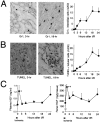Prevention of neutrophil extravasation by hepatocyte growth factor leads to attenuations of tubular apoptosis and renal dysfunction in mouse ischemic kidneys
- PMID: 15920173
- PMCID: PMC1602426
- DOI: 10.1016/S0002-9440(10)62498-4
Prevention of neutrophil extravasation by hepatocyte growth factor leads to attenuations of tubular apoptosis and renal dysfunction in mouse ischemic kidneys
Abstract
Ischemia and reperfusion (I/R) injuries occur in numerous organs under pathophysiological conditions. In this process, neutrophils play important roles in eliciting parenchymal injuries. Using a murine model of renal I/R, we show that hepatocyte growth factor (HGF) is a natural ligand that inhibits endothelial injuries and neutrophil extravasation. In mice after renal I/R, plasma HGF levels increased, along with c-Met/HGF receptor phosphorylation in the vascular endothelium. However, this c-Met activation was transient, associated with a decrease in endogenous HGF level, and followed by neutrophil infiltration and renal dysfunction. Suppression of endothelial c-Met phosphorylation by anti-HGF IgG led to rapid progressions of neutrophil extravasation, tubular apoptosis, and renal dysfunction. Inversely, enhancement of the c-Met activation by exogenous HGF blocked endothelial/tubular apoptotic injuries and acute renal failure. In this process, HGF prevented endothelial nuclear factor kappaB activation and inhibited induction of an adhesion molecule (ICAM-1), resulting in attenuated vascular edema and neutrophil infiltration. Thus, we conclude that 1) the HGF/c-Met system of endothelial cells confers an initial barrier to block neutrophil infiltration, and 2) transient and insufficient HGF production allows manifestation of postischemic renal failure. Our study provides a rationale for why HGF supplementation elicits therapeutic effects in ischemic kidneys.
Figures







Similar articles
-
Antinecrotic and antiapoptotic effects of hepatocyte growth factor on cholestatic hepatitis in a mouse model of bile-obstructive diseases.Am J Physiol Gastrointest Liver Physiol. 2007 Feb;292(2):G639-46. doi: 10.1152/ajpgi.00292.2006. Epub 2006 Oct 26. Am J Physiol Gastrointest Liver Physiol. 2007. PMID: 17068118
-
Opposite role of CD44-standard and CD44-variant-3 in tubular injury and development of renal fibrosis during chronic obstructive nephropathy.Kidney Int. 2014 Sep;86(3):558-69. doi: 10.1038/ki.2014.87. Epub 2014 Apr 9. Kidney Int. 2014. PMID: 24717295
-
Protective effects of peroxisome proliferator-activated receptor gamma ligand on apoptosis and hepatocyte growth factor induction in renal ischemia-reperfusion injury.Transplantation. 2007 Jul 27;84(2):207-13. doi: 10.1097/01.tp.0000269614.21367.3f. Transplantation. 2007. PMID: 17667812
-
Hepatocyte growth factor as mitogen, motogen and morphogen, and its roles in organ regeneration.Princess Takamatsu Symp. 1994;24:195-213. Princess Takamatsu Symp. 1994. PMID: 8983076 Review.
-
Hepatocyte growth factor in renal failure: promise and reality.Kidney Int. 2000 Apr;57(4):1426-36. doi: 10.1046/j.1523-1755.2000.00987.x. Kidney Int. 2000. PMID: 10760078 Review.
Cited by
-
Chitinase-like protein Brp-39/YKL-40 modulates the renal response to ischemic injury and predicts delayed allograft function.J Am Soc Nephrol. 2013 Feb;24(2):309-19. doi: 10.1681/ASN.2012060579. Epub 2013 Jan 4. J Am Soc Nephrol. 2013. PMID: 23291472 Free PMC article.
-
Leukocyte-specific protein 1 regulates neutrophil recruitment in acute lung inflammation.Am J Physiol Lung Cell Mol Physiol. 2015 Nov 1;309(9):L995-1008. doi: 10.1152/ajplung.00068.2014. Epub 2015 Aug 28. Am J Physiol Lung Cell Mol Physiol. 2015. PMID: 26320151 Free PMC article.
-
Multipotent Neurotrophic Effects of Hepatocyte Growth Factor in Spinal Cord Injury.Int J Mol Sci. 2019 Dec 2;20(23):6078. doi: 10.3390/ijms20236078. Int J Mol Sci. 2019. PMID: 31810304 Free PMC article. Review.
-
Involvement of the nuclear factor-κB pathway in the adhesion of neutrophils to renal tubular cells after injury induced by neonatal postasphyxial serum.Mol Cell Biochem. 2014 Mar;388(1-2):85-94. doi: 10.1007/s11010-013-1901-6. Epub 2013 Nov 26. Mol Cell Biochem. 2014. PMID: 24276753
-
HGF/Met Axis in Heart Function and Cardioprotection.Biomedicines. 2014 Oct 21;2(4):247-262. doi: 10.3390/biomedicines2040247. Biomedicines. 2014. PMID: 28548070 Free PMC article. Review.
References
-
- Beekhuizen H, van-de Gevel JS. Endothelial cell adhesion molecules in inflammation and postischemic reperfusion injury. Transplant Proc. 1998;30:4251–4256. - PubMed
-
- Jordan JE, Zhao ZQ, Vinten-Johansen J. The role of neutrophils in myocardial ischemia-reperfusion injury. Cardiovasc Res. 1999;43:860–878. - PubMed
-
- Lauriat S, Linas SL. The role of neutrophils in acute renal failure. Semin Nephrol. 1998;18:498–504. - PubMed
-
- Scarabelli T, Stephanou A, Rayment N, Pasini E, Comini L, Curello S, Ferrari R, Latchman D. Apoptosis of endothelial cells precedes myocyte cell apoptosis in ischemia and reperfusion injury. Circulation. 2001;104:253–256. - PubMed
Publication types
MeSH terms
Substances
LinkOut - more resources
Full Text Sources
Medical
Miscellaneous

